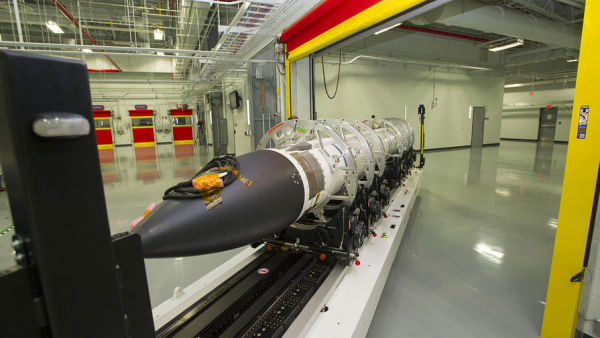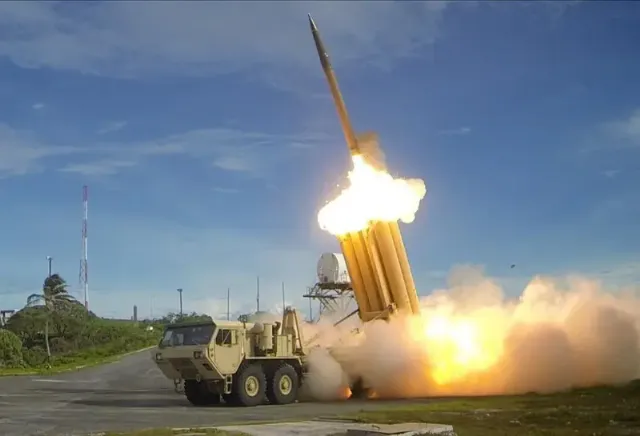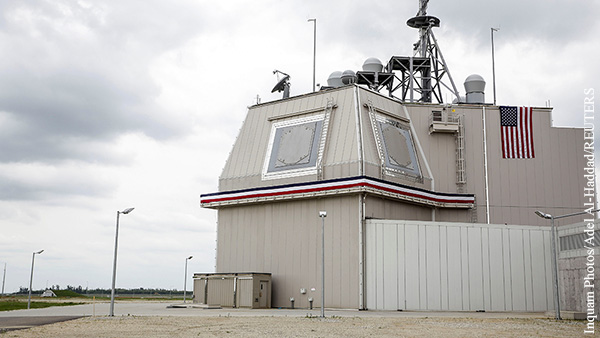Colonel Khodarenok linked the creation of the US Iron Dome with the testing of the Hazel
The United States continues to intensively improve its integrated missile defense. US President Donald Trump intends to create an Iron Dome missile defense shield to protect his country. How the United States is going to defend itself and whether the test of the Russian Oreshnik missile system has greatly influenced Washington's plans in this area - in the material of the military observer Gazeta.Ru" by Mikhail Khodarenka.
There is no doubt that the improvement of the US national missile defense system is largely due to the first combat use of the Russian mobile ground-based missile system "Oreshnik", which took place on November 21, 2024. On that day, an Oreshnik missile in nuclear-free equipment hit the Yuzhmash plant in the city of Dnepropetrovsk. Most likely, the launch of a promising product was carried out from the Kapustin Yar landfill. The range of the missile was about 800-850 kilometers. The speed of the warheads exceeded Mach 10.
US President Donald Trump recently announced that he would commission the creation of an "Iron Dome" to protect the United States.
"I will instruct our military to begin construction of the great Iron Dome missile defense shield, which will be fully manufactured in the United States," the head of the White House announced.
But even before the announcement of these strategic initiatives by Donald Trump, US efforts to modernize missile defense systems were significantly intensified. In 2025, $28.4 billion is expected to be allocated for missile defense in the United States, including $10.4 billion directly for the Missile Defense Agency (MDA), $9.5 billion for regional and strategic missile defense assets beyond the functions of the MDA, and $8.5 billion directly for measures to combat warheads. An ICBM.
For reference, the Russian military budget in 2024 amounted to $65.9 billion, that is, almost half of the Russian military budget in the United States goes only to work in the field of missile defense. And, quite possibly, after Trump's statements about the "great US missile shield," these allocations will be significantly increased.
The "Hazel Tree" factor
Let's say right away that in order to answer the question in the affirmative whether the missile defense systems available in the US Armed Forces are capable of hitting the Oreshnik, the Americans first need to create a hypersonic target missile roughly corresponding to the performance characteristics of the Oreshnik, then conduct a series of firing drills at the ranges, gain experience, accumulate statistics, and only this will make it possible to give an unambiguous answer. The answer is they can or they can't.
So far, there has been no information about such events from the United States.
Now about the missile defense systems available in the equipment of the US Armed Forces.
First of all, it is necessary to name GMD (Ground-based Midcourse Defense - "ground defense against missiles in the marching section of the trajectory") - the US strategic missile defense system, commissioned in 2005. It is designed to intercept intercontinental ballistic missiles and their warheads in outer space beyond the Earth's atmosphere.
In the coming year, the US Missile Defense Agency (MDA) will continue testing the long-Range detection radar (LRDR) in Alaska, with the planned transfer of this radar to the United States Space Force in the near future.
LRDR significantly increases the capabilities of the Missile Defense System (MDS) for threat recognition, allowing more efficient use of the arsenal of GMD interception tools.
Improvements to existing regional missile defense systems will include further improvements to the Aegis sea-based missile defense system and the deployment of SM-3 Block IIA type anti-missiles.
 |
| The SM-3 Block IIA rocket. |
| Source: SM-3 Block IIA |
The SM-3 Block IIA anti-missile system, designed to defeat intermediate-range ballistic missiles and intercontinental ballistic missiles, will be upgraded to increase the effectiveness of combating a wider range of threats and the possibility of hitting ballistic targets at long ranges. In this regard, it is planned to stop financing the purchase of SM-3 Block IB missiles in favor of SM-3 Block IIA missiles and focus resources on defense in the Indo-Pacific region.
The modernization of the THAAD missile defense system, a land-based mobile anti-missile system for high-altitude atmospheric interception of medium-range missiles (Terminal High Altitude Area Defense), and the further integration of THAAD batteries into the air and missile defense combat control systems of the US Army (Army's Integrated Air and Missile Defense Battle Command System, IBCS) will continue. Financing is provided for the purchase of an additional number of anti-missiles for the THAAD missile defense system. According to American experts, THAAD can intercept the Oreshnik missile. But these statements have not been confirmed by practical firing at target missiles.
 |
| Source: topwar.ru |
It is planned to create an all-angle (i.e. 360 degrees) missile defense system on the island of Guam, which is supposed to be done using the Aegis Navy, Patriot air defense systems and THAAD missile defense systems.
In addition to the MDA, the US Department of Defense is investing more than $9.5 billion in regional and strategic missile defense, including investments in the US Army of more than $4 billion to strengthen regional missile defense. The allocation of funds reflects the commitment of the US Department of Defense to create an integrated regional missile defense system compatible with systems deployed by US partners to defend deployed groups of troops (forces), allies and international partners from short- and medium-range ballistic missiles.
This involves the purchase of 230 PAC-3/MSE missiles and the supply of four batteries/divisions of lower-Tier air and missile defense systems (LTAMDS) and four batteries/divisions of maneuverable short-range air Defense (Maneuver Short Range Air Defense, M-SHORAD).
But efforts to maintain and modernize the missile defense fleet were planned even before Donald Trump's statements about the "great US missile shield." So a review of all these settings is most likely inevitable, and in the very near future.
Missile defense bases abroad
The Pentagon intends to continue efforts to support and operate the Aegis Ashore missile defense base in Romania and to deploy a second base in Poland as an integral part of the NATO missile defense architecture.
Upon completion of various tests, Aegis Ashore Poland will become a fully integrated and proven element of the US missile defense system and will be ready for operation under the command and control of NATO.
 |
| It is unlikely that the United States will dismantle the Aegis Ashore complex in Deveselu, Romania. |
| Source: Inquam Photos/Adel Al-Haddad/REUTERS |
There is a need to further improve the architecture of missile defense in general, including the ability to defeat enemy strategic cruise missiles. At the same time, it is planned to use both the capabilities of the US Missile Defense Agency (MDA) for Joint Tactical Integrated Fire Control (JTIFC) and the necessary coordination of efforts with the US Air Force.
Funding continues to support the development and production of joint missile defense programs with Israel, including the financing by the United States of the Iron Dome system for short-range missiles and rockets, as well as the joint development and production of the David's Sling Weapon System and the Strela missile defense system.3" (Arrow-3 System).
It's one thing to organize a missile defense system against Hamas water pipe clippings with a range of several kilometers, and it's quite another to defend against hypersonic warheads from potential US opponents.
Promising developments
This year, the United States will continue to develop the Next Generation Interceptor (NGI) missile, meaning the development and testing of a highly effective and reliable strategic interceptor to counter ballistic missiles from rogue states will receive a new boost.
The funds allocated for the ground-Based missile defense system (Ground-Based Midcourse Defense, GMD) will allow the deployment of a fleet of ground-Based interceptor missiles (GBI) and NGI in the near future. As for increasing the capabilities of the US missile defense, by the end of this decade, it is expected to increase the current fleet to 64 anti-missiles (44 GBI and 20 NGI).
The United States continues to develop a prototype hypersonic Glide Phase Intercept (GPI) system for delivery to equip troops in 2034. It is difficult to say anything specific about this system due to the lack of data.
Investments by the US Space Force in the near future are aimed at modernizing and maintaining strategic and tactical missile warning and missile tracking systems. These investments include the next generation of stationary infrared missile warning systems, low- and medium-Earth orbit missile tracking systems, upgraded early warning radars, and extending the service life of aging early warning systems.
The United States Space Development Agency (SDA) intends to invest in the development and demonstration of hypersonic tracking. Cooperation continues with the Space Forces and the Space Development Agency in the field of space sensors for tracking data on the use of weapons and the development of prototypes of hypersonic and ballistic space tracking sensors (HBTSS).
Advanced innovative technologies are at the forefront in the USA. When improving missile defense systems, special attention is paid to conducting a comprehensive, highly integrated, complex and cost-effective series of flight and ground tests, cybersecurity tests, simulations, war games and exercises. The United States believes that missile defense capabilities (MDS) must be reliably demonstrated and confirmed before delivering appropriate weapons to the customer.
But all this was, as they say, before that. The situation in the field of advanced missile defense development after Donald Trump's statement "on the great US missile shield" can be significantly changed and redesigned. Moreover, this is, without any exaggeration, a radically new course in the field of US national missile defense.
The opinion of the author may not coincide with the position of the editorial board.
Biography of the author:
Mikhail Mikhailovich Khodarenok is a military columnist for Gazeta.Ru", retired colonel.
He graduated from the Minsk Higher Engineering Anti-Aircraft Missile School (1976), the Military Air Defense Command Academy (1986).
Commander of the S-75 anti-aircraft missile division (1980-1983).
Deputy commander of the anti-aircraft missile regiment (1986-1988).
Senior Officer of the General Staff of the Air Defense Forces (1988-1992).
Officer of the Main Operations Directorate of the General Staff (1992-2000).
Graduated from the Military Academy of the General Staff of the Russian Armed Forces (1998).
Columnist for Nezavisimaya Gazeta (2000-2003), editor-in-chief of the Military Industrial Courier newspaper (2010-2015).
Mikhail Khodarenok

